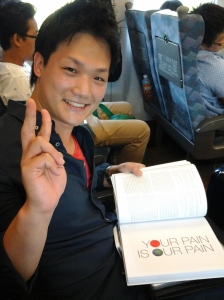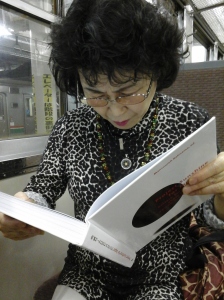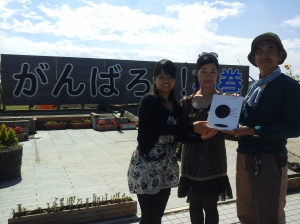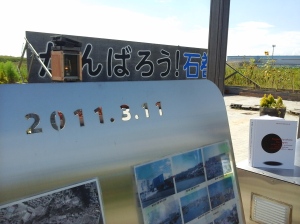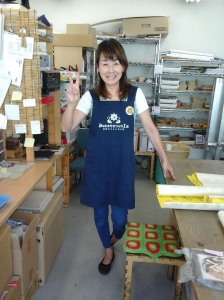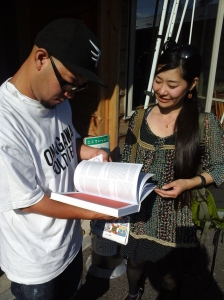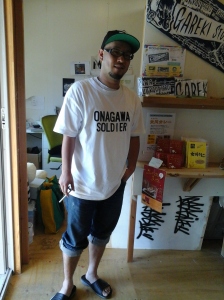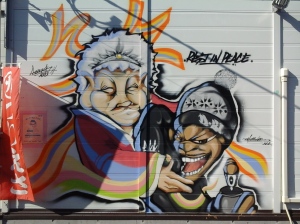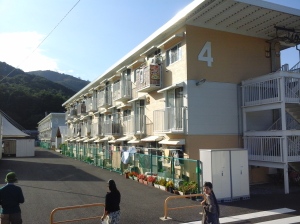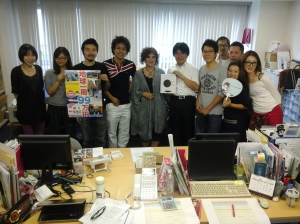2014 was incredible..
The project boards the Peace Boat in Ishinomaki
Wishing you all a peaceful year full of success!
Visiting the Peace Boat Disaster Relief Volunteer Centre in Ishinomaki, one of the regions most affected by the tsunami, was another of the main reasons for my trip to Japan. I had planned to visit Ishinomaki during the second week of my stay in the country.
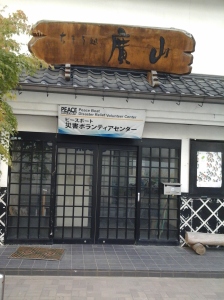
Peace Boat Disaster Relief Volunteer Centre in Ishinomaki
While I was on the road in Shinkansen and travelling on local trains to Ishinomaki, many people asked me why I was visiting Japan and why I was making my way specifically to Ishinomaki. I told them about Project Sunshine for Japan. The people I encountered were very interested in the project and wanted to read the Japanese passages in the book.
Arriving in Ishinomaki at 7pm, I was picked up by Peace Boat employee Akiko Iwamoto and one of the volunteers at the Peace Boat Disaster Relief Volunteer Centre, Ai Isobe. A friendly fellow traveller, who, during the journey, had read the book with tears in her eyes, accompanied me to the station exit and told me something. She thanked me several times for my work before leaving the station. On the way to the Disaster Relief Volunteer Centre, Akiko told me a lot about the city of Ishinomaki and what had happened after the disaster. When we arrived, I received a warm welcome from dozens of young volunteers and was invited to eat dinner with them.
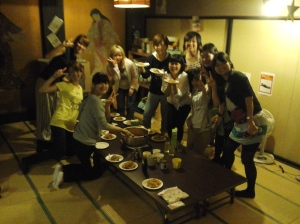
Young volunteers of Peace Boat Disaster Relief Volunteer Centre in Ishinomaki
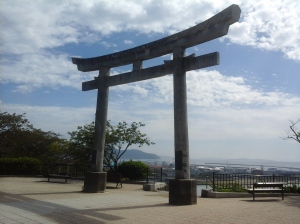
The view from the highest point of Ishinomaki
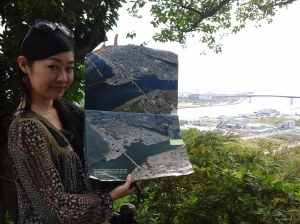
Akiko Iwamoto showing us the before and after the tsunami
My second day in Ishinomaki started with a speech given by Akiko Iwamoto to the volunteers. We then went on to plan for the day. My name was written in Latin script on a blackboard. After another short speech by Akiko Iwamoto, we embarked on a tour of the city. Local villager Masayuki Mouri picked us up for the tour, which began at the highest point of the city, and we drove through the countryside around Ishinomaki. The entire area looked like a building site; in many places, plaques could be seen with candles, flowers, food and something to drink for the dead. When it is hot, relatives of the victims share soft drinks with their dead. Many tourists who have come to visit the disaster area travel by bus to view the site. We went to a place created by Kenichi Kurosawa one of the citizen of the Ishinomaki who is very committed to the victims and built a memorial in the region. He explained how he tries to give people courage and to lift their spirits by recording his thoughtful words about the incident in two languages.
From Left to right Ai Isobe, Akiko Iwamoto and Masayuki Mouri
My itinerary included a visit to a temporary shopping street and apartments in Onagawa. My journey took me through deserted streets, as apart from some road construction workers, the place was completely empty. I visited several shops whose owners had used creative business ideas to try to leave the terrible events behind them and start a new life.
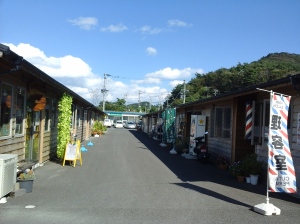
Temporary shopping street in Onagawa
Some even hope to be able to establish new labels from the region. One such woman is Namuri Abe, who is trying to open up a new market in the area by importing ceramics from Spain and using them to create artwork. She offers jobs to young creative people. A very interesting example of her business’s artwork is called Cera & Mika. Consisting of two fish happily stretching their heads out of the sea, the creation is a symbol of the town of Onagawa. The piece represents the first steps of reconstruction and the fact that life goes on.
Another business idea comes from an artist who paints graffiti locally and draws manga. Through his art, he tries to add colour to towns and cities, such as Ishinomaki and Onagawa, in which manga is popular. Picking yourself up again and rebuilding destroyed areas after such a disaster requires enormous energy, energy that is palatable among these young creative people.
One of the many examples of national and international development assistance in this area is the establishment of a communications tent for people living in shelters in Onagawa by Ruyichi Sakamoto. During our visit, we met two little boys who had been driven by the summer heat to play ball inside the tent and two women who met there daily to exchange news. However, we met no other locals. In fact, the town and its communications tent looked so empty! We met more people at noon, as we took a break in the area’s only fish restaurant. After the events in the region, this small seafood restaurant is one of the few remaining in the region that still serves fresh fish every day that it has caught itself.
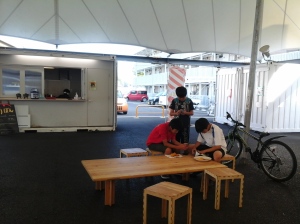
Communications tent for people living in shelters in Onagawa by Ruyichi Sakamoto
Afterwards, we visited the hospital in Onagawa. Many tourists were gathered here. A mark indicating the height of the tidal waves can be seen on columns at the entrance to the building. From the top of the hospital, the trail of destruction left by the tsunami is still visible. Even a completely upset building remains. When the flood hit, many villagers were sat in their cars listening to the news. They had been assured that the tsunami waves would crash into the town before returning to the sea. However, the tsunami pushed sideways into the town, changed direction behind the hospital and dragged everything back with it. The people listening to the news in their cars were all washed out to sea.
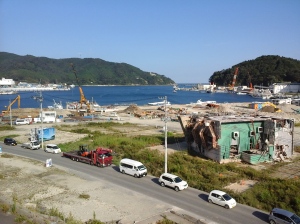
Crashed house in front of hospital in Onagawa
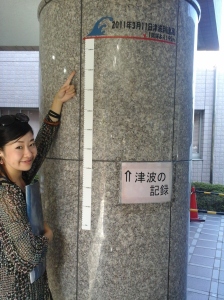
Akiko Iwamoto in front of the hospital in Onagawa
Later in the evening, we visited Ogatzu, where we took a break in a newly decorated coffee shop. Its young Japanese owners had moved here from other parts of Japan and had found a lucrative business opportunity in the area. Before the tsunami, more than 600 families lived here but the place is now deserted. Since the disaster, no more homes may be built in this beautiful valley on the coast and only businesses may take up residence. Only a scattering of houses are being built on high ground in the village.
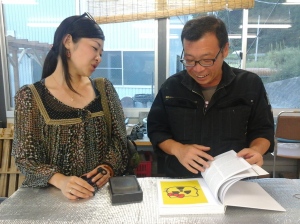
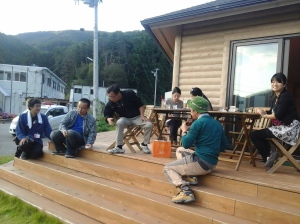
Coffee shop and villagers in Ogatzu
The evening ended with a visit to the village’s only primary school. After the disaster, it was completely destroyed and all two hundred pupils died. The atmosphere surrounding the building was heavy and oppressive, although now and then a sound could be heard coming from the school. Akiko asked me to take as few photographs as possible because tourism bothers many of the villagers. Somehow, the tsunami was still in the air, and the thought of hearing two hundred children scream soon stopped me from getting out my camera and I decided to refrain from taking photos. That evening, I returned to the Volunteer Centre and processed what I had seen and heard during the day. While eating dinner with the volunteers and talking with the young people, it once again became clear to me that life goes on.

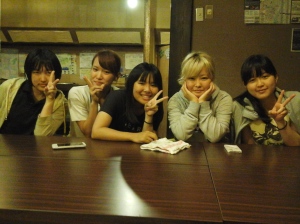
Young volunteers of Peace Boat Disaster Relief Volunteer Centre in Ishinomaki
The next day, I met Robin Lewis, another Peace Boat employee, right in front of the main train station in Tokyo. We had time to go for coffee together. The plan was for me to stay in Tokyo over the next few days. My visit to the Peace Boat and Japan Grace office and my cheerful welcome from the Japan Grace executive director, Yasuhiro Takada, and his staff left me feeling perplexed. In each department I visited, all the employees applauded me for my work, praised the project and gave me a friendly welcome.
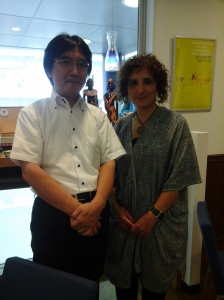
Japan Grace executive director, Yasuhiro Takada
Founder of the Project Sunshine for Japan, Mansoureh Rahnama
I was ashamed that I had failed to carry out work that I could have done earlier but had neglected to do for a number of reasons. In spite of this, the staff congratulated me for my dedication and hard work. I had the feeling that I did not deserve such effusive praise and that I could have done better. Nevertheless, I thanked everyone for their kindness, their warm welcome and recognition. It motivates me to continue to work for such wonderful people.

